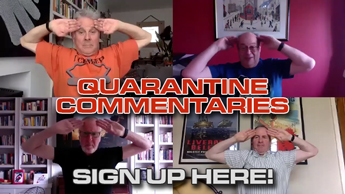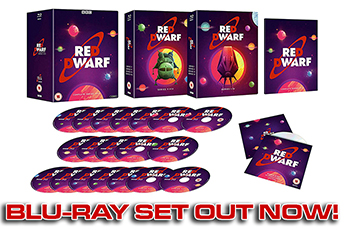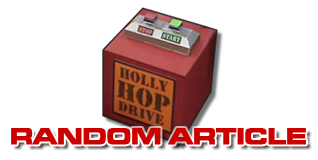 |
Fuller Flibble As High Heels and Lowlifes enters cinemas, the writer of the film - and co-author of the sixth most popular episode of Red Dwarf ever according to a fan club poll - talks into the penguin's microphone. |

Andrew Ellard
Mr Flibble passed his first question for Kim on to Andrew. It included a request for Minnie Driver's phone number, and Andrew ignored it - choosing instead to ask if the NOT THE 9 O'CLOCK NEWS revival has brought any of his own favourite sketches to light.
What I used to do, because I realised that television producers and editors change things without asking you - you can't have any hang-ups about having your work messed around with - I used to write a lot of sketches without any words in so they couldn't do that. (Laughs) A lot of the film quickies. Cutting together incongruous pieces of footage. I did one with Mel Smith, a sort of One Man and His Dog thing. He was standing there whistling at something, and then you cut to the Serengeti with a cheetah about to pounce on a wildebeest.
One of the favourite ones, which they do repeat, is the space shuttle taking off - with the sound of a lorry starting up. I remember I thought of it one day when it was really cold and I was asleep and this lorry woke me up trying to start. (Does lorry impersonation - impossible to replicate.) I just thought, for some reason, 'That's not bad, let's stick it over the space shuttle.' They keep showing that one - I get point-five of a penny...
When did you first work with ROB GRANT AND DOUG NAYLOR?
That was pretty early on - Jasper Carrott, Carrott's Lib. That was a turning point for me. Up to then I'd been doing sketches and turning them in, not really being involved with the production as such. Then Paul Jackson, who produced that show, wanted to get a team of writers together and pay them properly so that they came in every day. They paid for ten minutes of material a week regardless of whether you got anything on, which meant you didn't do any other work. The only reason writers tend to do ten things at once is that they don't get paid enough to do one thing.
That was where I met [Rob and Doug]. They were actually more experienced than me, they'd done a lot of radio. Their show [Son of Cliché] was hilarious. They did these links after the show into the continuity announcer. They'd deliberately write these, "And now we're going to pass you over to so-and-so who's very upset at the moment because his wife's left him. He's feeling bad, but do listen... " (Laughs)
They had a really good, off-the-wall sense of humour. The next time [I worked with them] was on Spitting Image. They turned Spitting Image round and made it work.
How did you get involved with writing BLUE for Red Dwarf VII?
I think Doug just phoned me up. When they stopped working together he was doing a longer run of shows. I think Doug was just looking for other writers that might be interested. I was really chuffed that he phoned me up, because I hadn't seen him for a while.
I like the way he works on Red Dwarf. He's very scrupulous about the script. It's a writer-led show, which is, I think, why it's so good. I'd watched it, obviously, but I wasn't avidly up to date with it. He was just introducing the Kochanski change at the time, and they sent me the Bible of it - about 200 pages long! I just had to get my head round it all, then came up with a storyline that we talked about and tweaked around.

It was quite a tricky series, because Chris - by that point - wasn't going to be in it. So we were thinking around how you'd get him in it without him being in it! My one was the notion of him coming back in 'retrospect' almost. It was good fun. It's a hard show to write, there's a lot of history and so many fans. If you make mistakes continuity-wise they'd have you. (Laughs)
When mine went out, Kochanski had already appeared, but there was a time when mine was going to be her first appearance. So we thought about that a bit. It was just a question of getting the premise right. With me I like to try to get an ending as soon as possible so I know where I'm going.
There were some CLASSIC SCENES in that episode - not the least of which was the Rimmer/Lister snog!
Once I'd got the notion of him having this nightmare where Rimmer comes back... What I like is the cheat of letting the audience think it's really happening, and then it isn't really happening. In Red Dwarf you can go where you like, everybody's on their toes and it's quite nice to keep second-guessing what they'll think. It's a bit like conjuring.

When you've got an endearing villain like [Rimmer] you can play with that a lot. It's a bit like Danny DeVito in Taxi. He's actually quite horrible, but you need him and you like him. [Rimmer]'s so vulnerable underneath - you know he probably cries himself to sleep. That's what works.
And the Rimmer munchkin song contains every known rhyme for Rimmer on Earth!
You know what, when I wrote for Lenny Henry in his show, I had to come up with... we did a parody of Thriller. I used to write a lot of parody songs, and that one [was] even harder - you've got 'iller', 'miller'. I got 'dinner' in actually, I got away with that. It's not too bad to rhyme, Rimmer. The first thing you do is drag out as many 'Rimmer' rhymes as you can and they you lay them out on a page and work backwards. Try to save the most contrived one, the most unexpected one, until the end.
Where did you get the idea for HIGH HEELS AND LOWLIFES?
It's based on a real event, a robbery in the early 80's. I read something about this guy - a gang were drilling into a bank, there was a lookout on top of a building nearby who was on a walkie-talkie to them throughout a weekend (it was a big wall they had to get through), and a radio ham overheard it!
I thought maybe that was a good idea for a film, because the guy could have heard enough information to blackmail them. I had it in my head for years. I started writing it [about] a sad bloke in a room, maybe he lives with his mother or whatever, the underdog. I liked the idea of an innocent, ordinary person getting involved with the underworld - but in a way that was safe, by phoning them up, not having to be risking much.

But it wasn't working as a bloke, this sad guy. He's got to talk to somebody, because the tension is about him planning what to do. Then I left it for a while and did the Spice film - they were going to do a film that didn't happen, so I wrote that on-spec - and came back to High Heels (which at that time was called The Big Con). I just hit on this thing [with] his girlfriend, and then another girl. I thought it's more fun, more interesting and less predictable.

Let's talk about your CAST - the Minnie Driver and Mary McCormack have a great on-screen chemistry.
They're great together. They're very energetic on screen. Minnie holds her character back to let Mary be more dominant in the story, because Mary's the one who takes over. They look great, and they're very funny. They've both done comedy. We went through the script for a week with the actors and I was there changing it, and they were all very positive about it. It's hard to find female comedy actors.

I imagine the Mark Williams and Kevin Eldon coppers were the most fun characters to write for...
They were - the trouble is you have to hold yourself back, because it's easy to have the two daft policemen. They are very funny together, but it is a comedy thriller and we wanted it to be exciting, not make it too daft. They played it really well, though. It's a little leitmotif in the film, you like coming back to them; it's like a running joke.
Mr Flibble enjoyed talking to Kim Fuller, and now that it's over... Mr Flibble is very cross.














